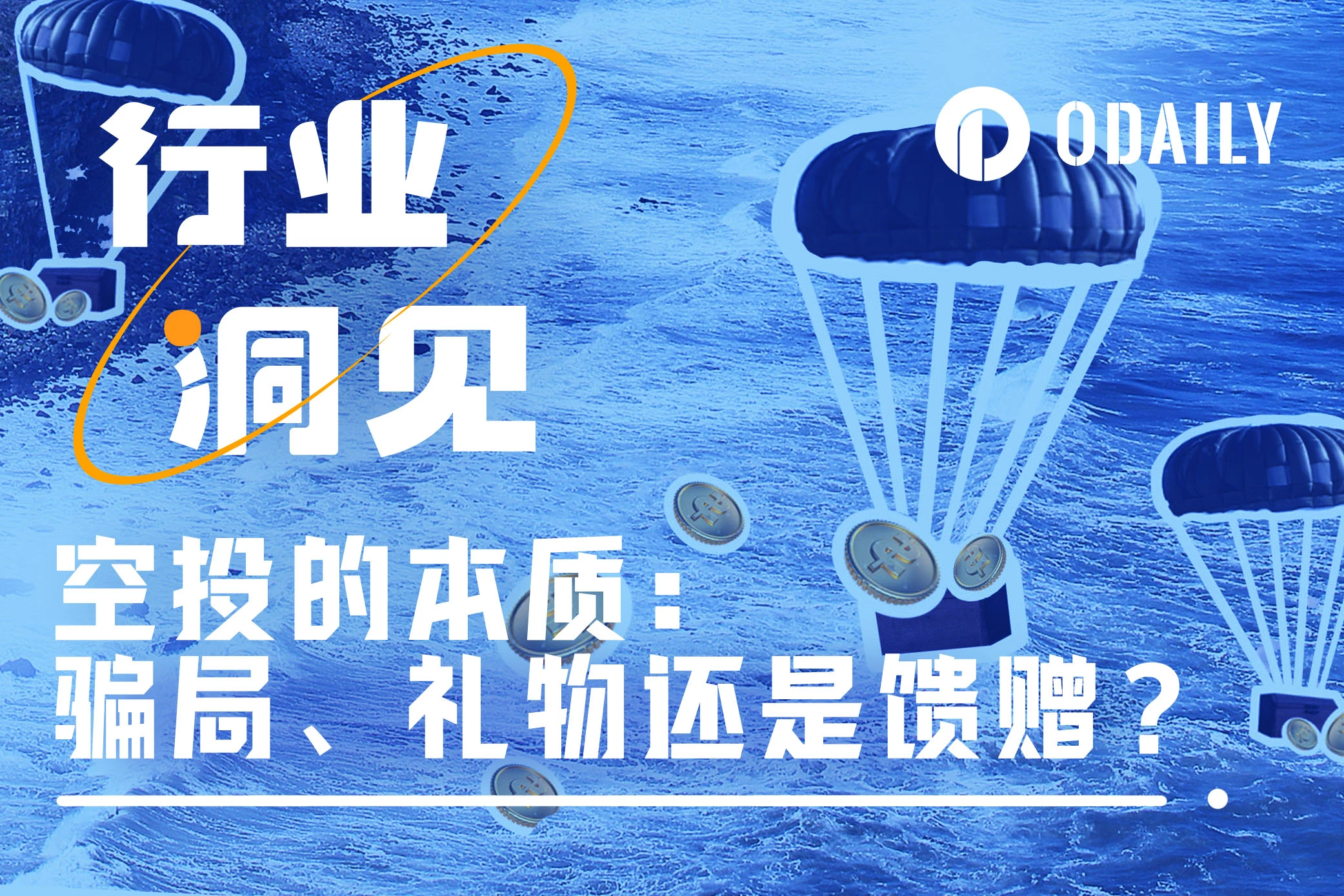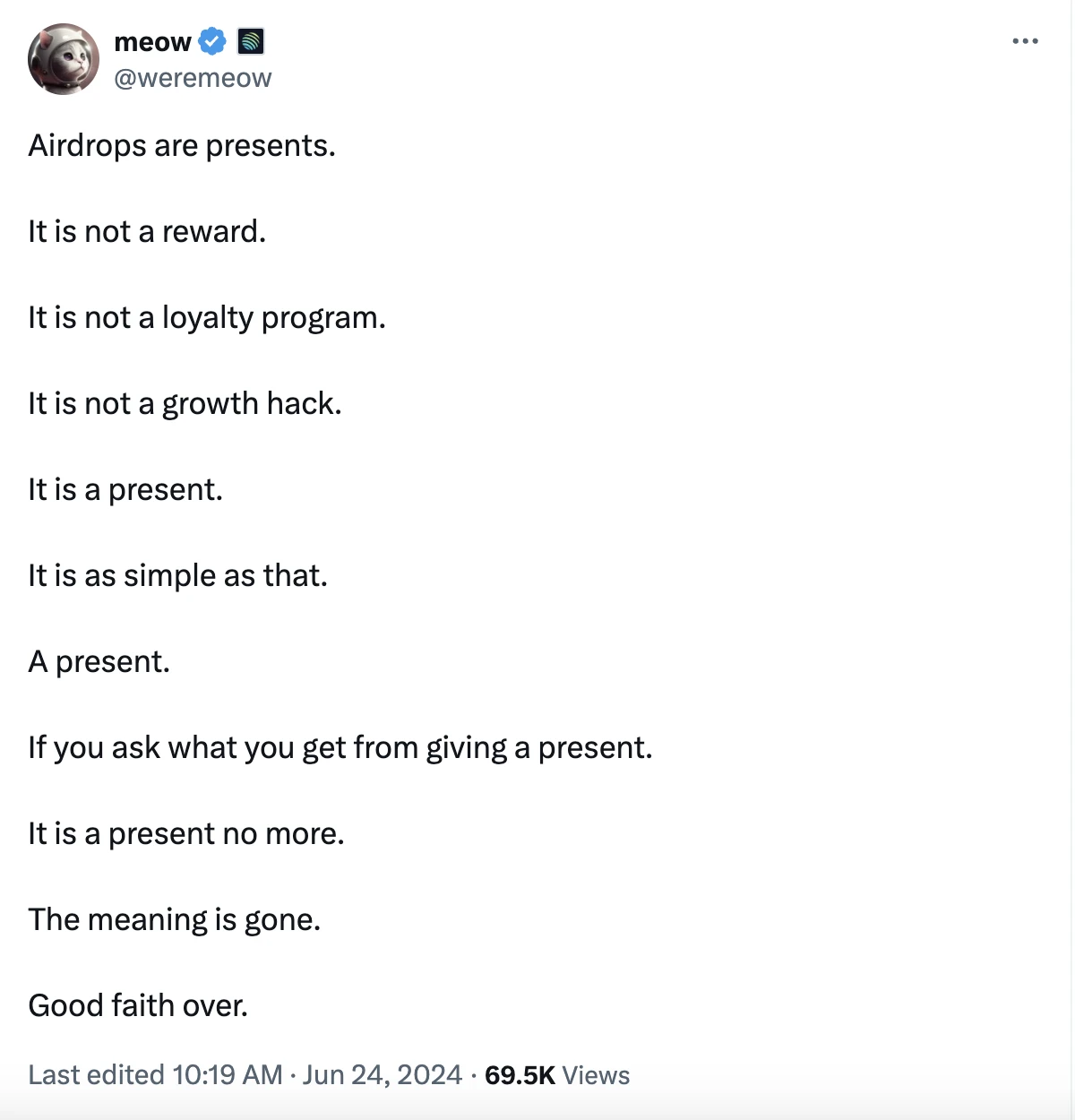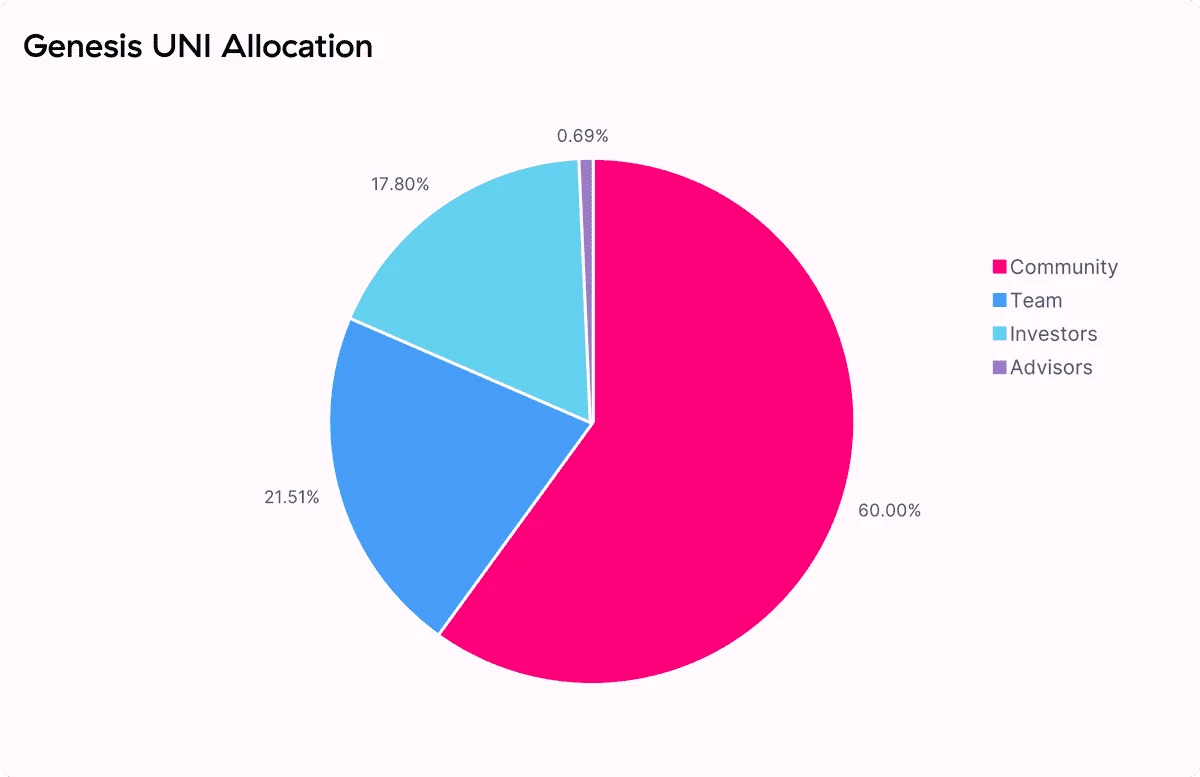Original|Odaily Planet Daily
Author: Wenser
The ZK (ZKsync) and ZRO (LayerZero) token airdrops have come to an end amid criticism and dissatisfaction. The Blast airdrop, which is the highest interest rate deposit in the L2 network, is also on its way. The soul-searching question of what is an airdrop has once again aroused widespread market discussion. Odaily Planet Daily will combine past industry views and recent key figures remarks in this article for readers reference.
Jupiter Lianchuang: Airdrops are gifts, not rewards, loyalty programs, and growth tools
As the discussion about whether ZK and ZRO are the Endgame of airdrops is raging, Jupiter co-founder Meow posted on the social media platform today: Airdrops are gifts. Its not a reward, its not a loyalty program, its not a means of growth. Its just a gift. Its that simple. If you ask what you can get from it, its no longer a gift, and then it loses its meaning and its original sincerity. Goodbye. (Spanish)
Interestingly, Meow deleted the word Adios (goodbye in Spanish) from the last sentence in subsequent versions, perhaps because they felt that the word was inappropriate, or perhaps because they felt that the attitude of saying goodbye to users expressed by this word was too decisive.
But it can be seen that he regards airdrops as an intermediary vehicle for friendly interaction between project owners and users – just like a gift brought by a friend visiting your home. If there are gifts, it would be good, but if there are none, you should not vent your anger on the project owner.
Tweet screenshot
LayerZero CEO: Creating a precedent for donating before receiving airdrops
As a leading project of cross-chain interoperability protocol, LayerZero was previously highly expected by the market. Its token airdrop expectations were once comparable to those of ZK (ZKsync), one of the former Four Heavenly Kings of L2. However, the attitude of the project CEO Bryan Pellegrino (hereinafter referred to as Bryan) towards the token airdrop is obviously different from the ZKsync official accounts direct statement that no large-scale witch screening will be carried out. Previously, perhaps in order to ensure that real users get the airdrops they deserve, LayerZero launched a vigorous witch hunting movement on the X platform for nearly two months. At that time, many wool-pulling parties were in danger, but in the end, the single-digit and double-digit airdrop results of a single account disappointed many people – I thought the big one was coming, but I didnt expect it to be big, but it was a big one, which is worthy of being done by the stinky penguin (Bryans username suffix on the X platform).
Not only that, as the CEO of LayerZero, Bryan obviously has his own opinions on the token airdrop.
On June 20, in response to the requirement to donate tokens worth $0.1 per ZRO token before claiming the LayerZero airdrop, Bryan said , There is no forced donation. If you dont want to donate, dont apply for tokens. This is not something you own, but something provided by others. Combined with his previous behavior and remarks, Bryan sees the token airdrop more as a charity or even a bribe from the project party to the users. Therefore, to some extent, users have the need and obligation to contribute their own strength to the subsequent development of the project through donations.
It has to be said that now that token airdrops have entered the mature development stage, the implicit rule of conspiracy between project parties and users on token airdrops has become invalid for LayerZero and Bryan. The two parties are no longer comrades-in-arms who jointly support the valuation and market value of the project, but have become enemies who are hostile to each other.
In response to LayerZeros mandatory donations, Yearn core developer banteg commented that such mandatory donations are more like a glorified ICO. At the same time, he also called for an end to the bulk funding of the Protocol Guild because it has been very successful in attracting funds and should look for other smaller initiatives to support.
Uniswap founder: “Don’t be stingy with token distribution”
As an industry pioneer and crypto giant who launched the token airdrop track in September 2020, Uniswap founder Hayden Adams (Hayden for short)s views on token airdrops may be more in line with the expectations of most people in the cryptocurrency market. More importantly, this guy really puts his knowledge and actions into practice.
-
The previous Uniswap airdrop received unanimous praise from almost everyone in the market;
-
UNI tokens received active participation from 13,000 users within three hours of launch, with gas costs reaching $650,000;
-
The threshold is clear and relatively low, mainly distributed to historical liquidity providers, interactive users and SOCKS redeemers/holders etc. based on the snapshot on September 1, 2020;
-
A single user address could receive 400 UNI tokens, which were worth $1,344 at the time. Just a few months later, the value of this airdrop reached nearly $12,000, which is truly a big deal.
UNI Token Distribution Chart
It is worth noting that Uniswap’s token airdrops at that time had complex internal and external reasons: internally, community members kept urging for token issuance, and externally, it faced fierce competition – the most direct influencing factor was the competitor SushiSwap’s “vampire attack” through token issuance. According to media reports at the time , from September 7 to 9, 2020 , Uniswap TVL fell from US$1.72 billion to US$2.6 billion in 48 hours. Although it briefly rose to over US$1 billion on September 10 and quickly regained its market leadership, competition has become fierce .
At that time, Ethereum co-founder Vitalik Buterin also left a message in FTX CEOs tweet commenting on the SushiSwap incident to express his views. He believed that Uniswap founder Hayden Adams was an excellent industry participant, and the team had worked hard for several years and made an upright decision. When others were ICOing as quickly as possible, Uniswap was not in a hurry to issue coins, but it was attacked for this in the past two weeks. I have seen Uniswap has been developing since its launch, and it is not true to say that Uniswap is irresponsible to the community. It can be said that it is a direct platform and expresses support.
In May of this year, when the points system dominated many crypto projects, Hayden also expressed his views on issues related to token distribution . In addition to his clear-cut belief that tokens are needed instead of points, the most important point is that he believes dont be stingy with token distribution. His original words were: Dont be stingy – give away a lot generously. If the project founder believes that the community does not deserve a lot, please dont release tokens.
In addition, he also mentioned: Don’t blindly pursue the number of Farmers; ensure real liquidity from day 1; don’t provide biased Farmers with too high a token supply; don’t push token prices; keep it simple; put real thought and care into token decisions.
As early as July 2023, Hayden said publicly that he hoped to see more projects use the superpowers of Crypto to subvert mainstream Web2 Apps and discover new use cases, rather than making marginal improvements around the few existing Web3 use cases (AMM, lending, etc.), launching vampire attacks on Web2, and stopping forking Uniswap.
The author believes that in Hayden’s eyes, airdrops should be a means of dealing with market competition, a bond that can create more connections with the community, a medium that can be invested with real thinking and care, and a superpower that can launch a vampire attack on Web2, rather than a variant of points that is only meant to be stingy.
Conclusion: The essence of airdrops – alternative marketing investment
In the eyes of users who have interacted with them countless times but have not received any airdrops or whose airdrop returns are not enough to cover their expenses, airdrops are often a scam – I value their token airdrops, and they value my principal and handling fees;
In the eyes of VCs, funds, and investors who have invested in many crypto projects, airdrops are a natural “return on investment” – “I invested so much money, time, and energy in the early stage, and now I get back some of the tokens as a reward, isn’t it reasonable?”
For some founders and team members who believe that the success of the project is mainly due to the project party itself, the airdrop is a gift to users who actively cooperate with the work and a gift that you should cherish. Even if you dont shed tears of gratitude, you should at least be grateful, right?
But in fact, in my opinion, just as the main product in the Web3 field or the cryptocurrency industry is Token, token airdrops are actually an alternative investment for accumulating seed users, external publicity and promotion, and product brand marketing.
The project party should neither be too generous to the point of distributing most of the tokens to the fleecing party, big brushes and cluster witches; nor should they be extremely stingy to the point of making the loyal users who have truly accompanied the project from 0 to 1 or even 100 feel disappointed or even become enemies.
A qualified token airdrop is like a marketing campaign, which is based on clear goals and serves the overall development of the project. After careful thinking and detailed planning, and through step-by-step execution, it will eventually achieve a certain degree of decentralized distribution of token chips and successfully shape the projects market reputation and brand image.
Therefore, future project owners should reach a consensus: token airdrops are a sub-proposition of marketing, and airdrops that only have negative effects are worse than not being issued.
This article is sourced from the internet: The Nature of Airdrops: A Scam, a Gift, or a Giveaway?
Related: Meme coin trader: The ten meme coins you bought might all be issued by me
Original author: Mia, ChainCatcher Original translation: Marco, ChainCatcher When talking to ChainCatcher about the release of Meme, Lao Mai (pseudonym) used an old joke: How many steps does it take to put an elephant into a refrigerator? In Lao Mai’s opinion, a Meme project is like “putting an elephant into a refrigerator”, which only requires three steps: preheating coin issuance, market value management, and community maintenance. During Meme Summer, ChainCatcher talked to several Meme coin traders. Some of them actively issued Meme coins following the hot topics and then operated the projects; some issued Meme coins wholesale, issued a lot of them, and kept changing the hot topics; some bought Meme coins and became shareholders and operators of the projects. In this wealth-creating movement, human joys and sorrows are not…











I want to share my experience regarding a Bitcoin investment scam involving Coinyee, where I lost over $375,000. Fortunately, I was able to recover my funds with the help of [www.BsbForensic.com] They are truly one of the rare services that can help in such situations.
If anyone is facing a similar issue, I highly recommend reaching out to them for assistance.